“I couldn’t tear myself away from the image of the Maheshmurti. It was so beautiful. So mesmerising. Elephanta was so nice,” gushed Iskra, an exchange student from Bulgaria.
I listened to Iskra’s description of her visit to Elephanta Caves with part fascination and part envy. The reason? In spite of having lived in Mumbai for nearly 23 years, I had never been to the Elephanta Caves. Listening to Iskra, and that too a foreigner, rave about them needled me into resolving to visit the caves at the earliest opportunity.
And would you believe it? The opportunity presented itself to me the very next day, almost as if it was just waiting for me to make up my mind. My Facebook wall announced that Girls on the Go (GOTG), a women’s only travel club, was conducting a guided day trip to the Elephanta Caves on 13 March 2011. Would I be interested? Not one to let go of an opportunity like this, I signed up for the trip within seconds of seeing the intimation. 😀

So, on D-Day, I was at the Gateway of India much before the reporting time of 7.45 am. While waiting for Piya Bose, the founder of GOTG, and the rest of the group to assemble, I tried to recall what I knew about the Caves. They were … um… really old rock-cut caves, were located in Elephanta Island some distance away from Mumbai, could be accessed only by boat, and was a UNESCO World Heritage Site. In short, I knew nothing about the Caves. Of course, by the time the tour got over I was a little wiser thanks to Lakshmi Kishore, our guide, and a booklet on the Elephanta Caves that I purchased from the ticket office.
Elephanta Island has traces of habitation from 2nd century BC in the form of remains of a Buddhist stupa, reportedly built by Emperor Ashoka himself. But what the Island is really famous for are 7 rock-cut caves, whose age is not well established due to absence of written records. Various theories exist as to the age of the caves as well as to who built them, and according to the Archaeological Society of India’s (ASI) booklet, the caves were excavated during the middle of the 6th century, during the rule of the Konkan Mauryas.
Locally, Elephanta Island is known as Gharpuri and is located about 11 km from Mumbai. It was called Elephanta by the Portuguese, who found a stone statue of an elephant at one of the entry points to the Island. Though they tried their best to destroy the statue, they only succeeded in severely damaging it and today the restored elephant is installed at the Bhau Daji Lad Museum in Mumbai.


Our group of 16 women took one of the first ferries to Elephanta Island, which is about an hour’s travelling time from the Gateway of India.
I was surprised to see the number of ships anchored off the Mumbai coastline, and their different shapes and sizes as well. Some looked like freight ships, some looked like oil bearing ships, some looked sleek, some were bulky…It was a fascinating sight. There were also, what appeared to be, many chartered boats in the waters, heading out in a completely different direction.
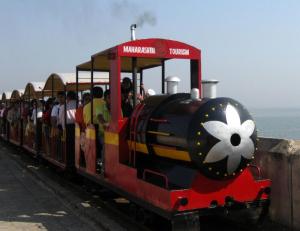
When we disembarked at Elephanta Island, after a soothing and refreshing ride, I could see a picturesque village in the distance, as well as a toy train waiting to take passengers to the base of the climb to the Elephanta Caves. The scramble to grab seats in the cramped train had to seen to be believed. There were some children who were actually jostled out by adults for a seat on the train. It was very hot and I guessed the tourists wanted to avoid the sun as much as possible.

I chose to walk to the base of the caves, which was only a 5-minute walk away. The climb to the Caves is—for most part—a gentle incline and it takes about 15-20 minutes if you are not distracted by the numerous stalls selling trinkets or stop for a refreshing drink or just stop to look at the antics of the aggressive monkeys. Those who are unable to negotiate the climb, can hire “chair palanquins”. Though the climb was not strenuous, I still huffed and puffed my way to the top and to a view that was simply superb. See the picture below.
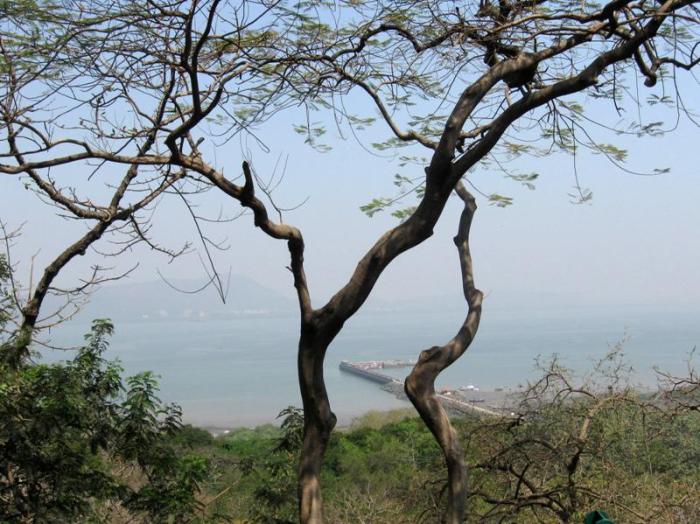
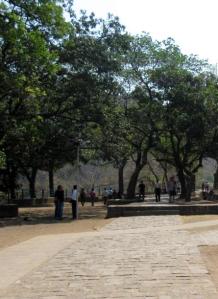
Our group had a little free time before our guide joined us. While most of the group members decided to have some tea, I chose to do a little exploring of my own before the official guided tour.
The cave complex, if it can be called one, is spread out in a setting that is understated and yet meant to impress. Cave 1, the main and the only completed cave, is the first cave that the visitor will see. The other caves, also known as minor caves, are further along and spring up as little surprises every few metres or so as one walks along the path. The entrance design for each cave is different from the other. The minor caves do not have any carvings in them and three of them are unfinished. Though Cave 4 has a lingam inside, it is otherwise quite bare.

- Entrance to Cave 3
I would have loved to go and see the remains of the Buddhist Stupa, but by the time I finished this quick exploration, it was time for our group to gather and meet our guide outside Cave 1. Predictably, Cave 1 was quite crowded with groups clustered around their guides and moving from one panel to another like some kind of a slow, shuffling dance. Our group, too joined this shuffle as we moved from panel to panel along with our guide.

Cave 1 is considered to be amongst the most impressive of the rock-cut caves in India. It is actually is a large squarish, many pillared hall with three entrances in the North, East and West. The main entrance is through the North door. Each of the entrances admit enough light to be able to see the sculpted wall panels without artificial lighting. There is an off-centre shrine, within the hall, which opens out in all four directions and each doorway is flanked by a pair of giant dwarapalas. Though the shrine has a lingam, it is no longer a place of worship these days, except on Mahashivratri day. In spite of that, I saw many people go inside and say a quick prayer at the lingam, or prostrate themselves or offer some flowers.
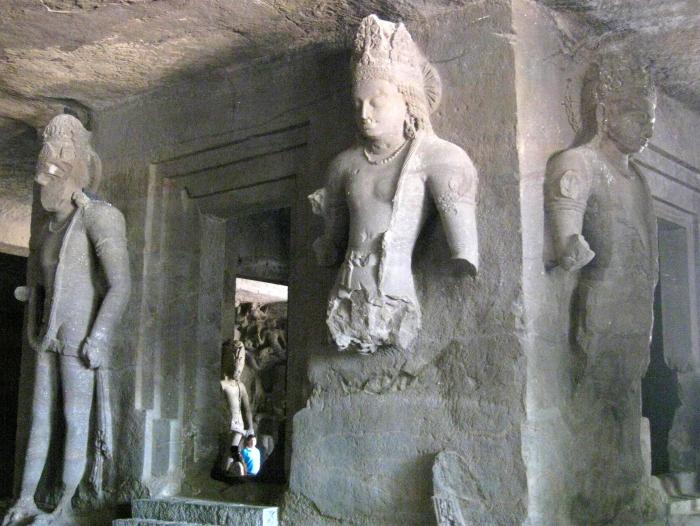
Cave 1 has 9 panels and all of them are in praise of Lord Shiva in various forms and moods — Shiva as Nataraja, Shiva as Mahayogi, Shiva as Ardhanarishwara, Shiva as Gangadhara, Shiva as the Destroyer, etc. All the panels have suffered heavy damage at the hands of the Portuguese who reportedly used them for shooting practice, no less. In particular, it is the lower portion of the panels that have suffered maximum damage leading to loss of details. Therefore, the stories that the panels depict have been inferred to by comparing it with similar panels elsewhere, for example, in Ellora.
I am awed by the size, the detailing (however mutilated), the positioning, the story-telling, and the love and devotion with each panel has been sculpted. Let me take you for a walk around the main hall in Cave 1 and show you each panel the way I saw it. We will proceed in a clockwise manner beginning with the panel to the left of the main entrance — the panel of Shiva as Mahayogi or Yogeeshwara.

Shiva is seated in a meditative, yogic pose on a lotus or padmasana. Though the details of the lotus have been destroyed, it is not hard to imagine seeing a petal here or a petal there. This panel depicts Shiva as Yogeeshwara or the supreme master of yoga and is said to answer Kalidasa’s description of Siva as mentioned in his Kumarasambhava. However, this is a controversial panel as experts are not decided if it is a sculpture of Shiva or that of Lakulisa, an ardent devotee of Shiva and a historical figure associated with the development of the Pasupata cult. Other figures in the panel include gods like Brahma and Vishnu, and celestial figures like Indra.

The next panel is one of the largest panels at the Elephanta Caves. In its original form, it would also have been the most detailed panel. The panel represents a story from the Shiva Puranas wherein the demon king Ravana tried to lift Mount Kailasa, the abode of Shiva, as it was a barrier to the free flight of his flying craft, Pushpak. Ravana’s sculpture in the lower half of the panel is almost completely mutilated, though some of his arms can still be seen at a particular angle. Also seen in the panel are Parvati, Ganesha and Vishnu. All this is not apparent immediately and experts have been able to reconstruct what this panel must have been like due to a similar panel at the Ellora Caves. What a sight the original panel must have been like !
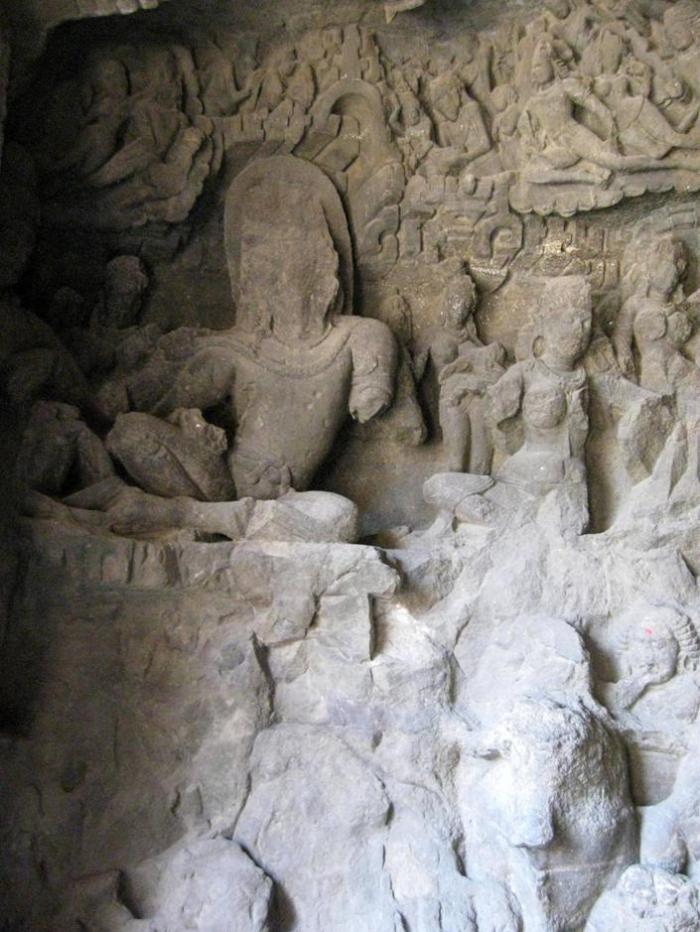
The third panel, too, has been destroyed to a point that the hand gestures of Shiva and Parvati are missing as is Shiva’s face. But, once again, based on a similar panel at the Ellora Caves the story has been reconstructed. The panel depicts a scene after a game of Chausar or dice, which Shiva has won through deceit. Parvati is angry with Shiva’s deceit and has turned away from him.

Ardhanarishwara represents the concept of the union between the masculine and the feminine and the next panel that we see in Cave 1 is that of Ardhanarishwara. Here, Ardhanarishwara is leaning on Nandi and the contrast between the masculine half (on the right) and feminine half (on the left) is beautifully detailed. This panel also depicts other gods and their mounts. So we have Brahma (swan), Vishnu (Garuda), Varuna (crocodile), and Indra (Airavata), among others. However, in my opinion, the Elephanta Ardhanarishwara is not the most beautiful one I have seen; that honour belongs to the one at the Mahakuta Temple near Badami.
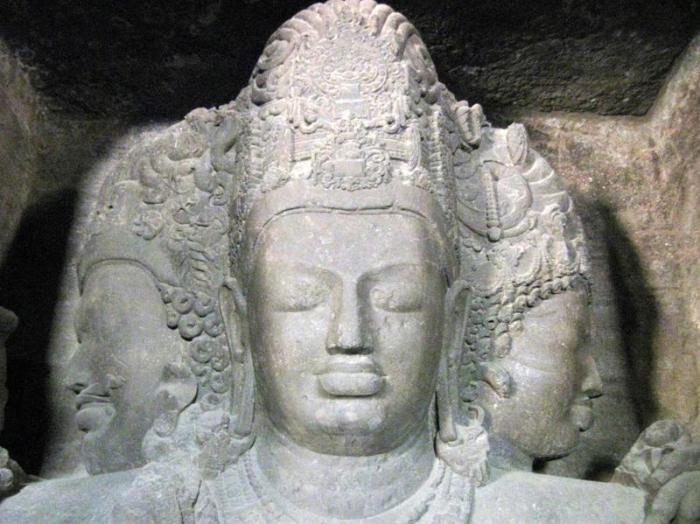
The Maheshmurti, also called Sadashiva, is the “star” of the Elephanta Caves. Every visitor gravitates towards this sculpture to “ooh and aah” over it, have their photographs taken with the sculpture in the background, and generally admire it. And why not? It is overwhelming to see the 5.45 m bust tower over you. No photograph or description can do justice to the Maheshmurti and you have to see the sculpture for yourself. Even as our guide stood in front of the sculpture and explained the finer details to us, all our eyes were on the sculpture, and I am pretty sure our jaws were hanging open too !
The Maheshmurti is not the Trimurti of Brahma, Vishnu and Shiva as many people think, but is a representation of 3 forms of Shiva. The central head, which exudes calmness and serenity, is called Tatpurusha. The right face of the Maheshmurti is Aghora or Bhairava or Rudra, representing Shiva in his destroyer aspect. This face is decidedly masculine with a curled mustache. The third and left face is highly ornamental and quite feminine and is known as Vamadeva. Amongst all the panels at the Elephanta Caves, it is only the Maheshmurti that has not suffered much damage. Perhaps, even the Portuguese were mesmerised by it !
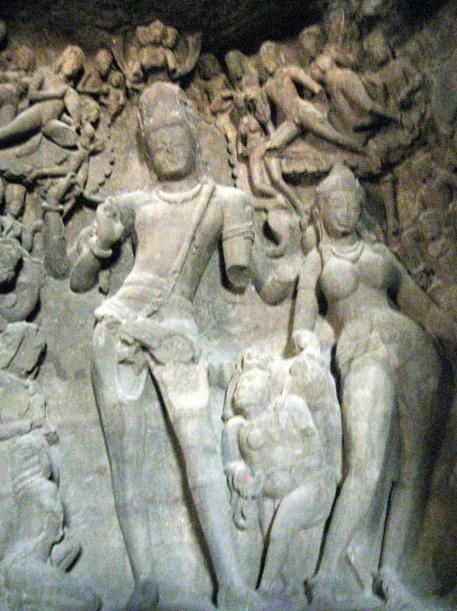
The Gangadhara Shiva panel is the only one in the Elephanta Caves where the lower parts have not been destroyed. Therefore, one can see the full, slender forms of Shiva and Parvati. Above Shiva’s head is Ganga, as a three-headed figure, probably representing the 3 holy rivers of Ganga, Yamuna and Saraswati. Vishnu on Garuda, Brahma on his swan, Shiva’s ganas, and a host of other male and female figures are also present in this panel.

The next panel, in my opinion, is the most beautiful one in Elephanta Caves. It depicts the marriage of Shiva and Parvati and is, therefore, called Kalyana Sundara Murti. I loved the expressions and detailing of this panel, particularly Parvati’s shyness. One can almost imagine a blushing bride here ! The panel illustrates the kanyadaan ceremony in which Parvati’s father is giving her away to Shiva, the groom. Brahma, who officiated as the priest, is also present in the panel as is Vishnu.
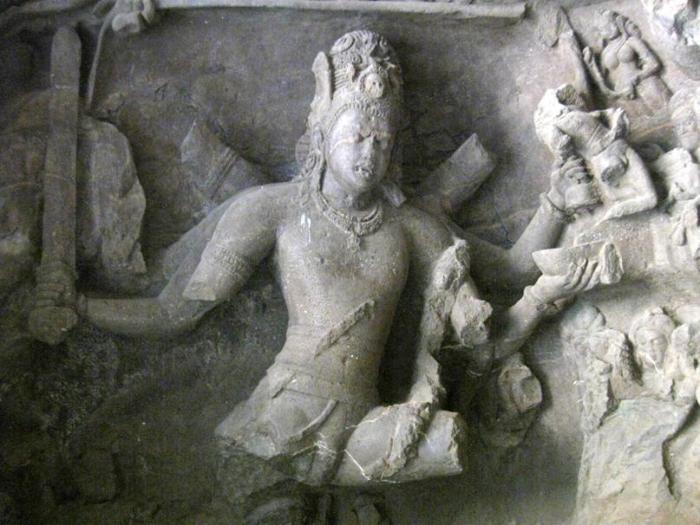
The next panel depicts Shiva in his form as the destroyer. He is shown killing the demon Andhakasura, who cannot really be seen as his sculpture has been destroyed. Though the sculpture is badly mutilated, the expression of anger and fierceness on Shiva’s face is unmistakable, even from a distance. Just looking at it made me shudder. I wonder what effect the panel would have had on me in its original form.

The Nataraja panel, which is to the right of the main entrance, has Shiva’s sculpture completely destroyed below the waist as have most of his 8 hands. This panel too has Brahma, Vishnu, Kartikeya, Ganesha and a comparatively smaller figure of Parvati to Shiva’s left. What caught my eye in this panel is the way a snake coiled around the staff (upper left corner) held by Shiva has been sculpted. It looked alive !
Cave 1 has an annexe or an eastern wing to which our group, led by Lakshmi, made a quick visit. It has some sculptures of dwarapalas and in an antechamber of the main hall, an entire wall has a panel depicting the Saptamatrikas, which have also been badly mutilated. The walls on either side of this panel have sculptures of Ganesha and Kartikeya on either side, and facing each other.
It was about 1.00 pm when we finished the tour of Cave 1 and said our thanks and goodbyes to our guide Lakshmi (she was seriously good). Our group was free to go and see the other caves, go for lunch or return to Mumbai immediately. I went to see the site museum, which was a real disappointment as it was very unimaginatively laid out.
After a quick lunch with some of the group members, I made my way back to the jetty and boarded the return ferry to the Gateway of India. The afternoon heat, combined with the overwhelmed feeling that I normally get after a good trip and the gentle rocking motion of the ferry, lulled me into a contemplative mood.
The Elephanta Caves did not exist as the bare stone sculptures we see today. The ASI booklet mentions that these sculptures were painted, probably in bright and vivid hues. Though traces of paint are supposed to exist on some sculptures, I could not see any. I tried to imagine the sight of these sculptures, brilliantly painted and unmutilated in all its pristine glory. I imagined people coming in to worship at the main shrine and getting awed at these magnificent sculptures. Who were the sculptors who created such works of art? Were they appreciated? Were they revered?
Gharpuri was a trading area for people from as far away as Greece and I tried to imagine what the Greeks must have felt about these sculptures. Did it remind them of their own gods? What did the Portuguese think of them? Why did they so callously destroy the sculptures?
Why do trips such as these raise more questions than it can answer? And probably raise questions that it may never be able to answer. Elephanta is definitely a trip that one must make at least once. But I think, I will go back again. There is the remains of the Buddhist stupa to see and of course gaze and take in all the panels in Cave 1 again.
Yes, I will definitely go back.

Sudha, I loved reding your post. You obviously got a lot more information than I did when I went up to Elephanta. These caves remind me of the beautiful caves at Badami…Its a truly humbling experience standing in front of these giant statues. I always think of the artists who made these stunning pieces of art. They worked with relativey primitive instruments for years on end even generations on end. There was no expectation of placing ones name on any of their work…just devotion to God and ones King…that kind of spirit seems to have died with the Ancients…
LikeLike
Badami is much more refined in terms of delicate details and the sandstone base gives thr rock-cut sculptures an entirely new expression. But, unlike the Elephanta Caves, I found that the sculptures lacking in expression. The delicacy of Parvati’s demureness or the gruesome raw anger of Shiva is missing in Badami, even in the Shiva themed caves. I haven’t seen Ellora yet, and have heard that those caves are the best.
LikeLike
Wonderful images of the trip. I was here in Dec 2010.
LikeLike
Thank you, Rajesh. Elephanta is quite something isn’t it?
LikeLike
Sudha, thanks so much for writing about the GOTG Elephanta trip. It was a lovely read. I am sharing this on my FB group http://www.facebook.com/pages/Womens-Travel-GirlsontheGo-Club/101830850307
LikeLike
Thank you for stopping by and commenting, Piya. I enjoyed this trip to Elephanta and look forward to many more day trips with GOTG. How about organising one to the Kanheri, Jogeshwari and Mahakali Caves on one day?
LikeLike
I have visited the caves many years ago and could only remember the Maheshmurti. The history of each cave and panel made fascinating reading. I always thought that the Maheshmurti was a representation of the Trimurti.
Reading about the wanton destruction carried out by the Portuguese was very saddening.
As an artist, I have always wondered about the sculptors. How did they manage to carve such marvels. The expressions on each image is so unique and beautiful. I do want to visit it again and see it from a new and more enlightened perspective.
LikeLike
Even I had thought that the Maheshmurti was the Trimurti. And yes, lets go and see Elephanta again. 🙂
LikeLike
Nice, comprehensive post! loved reading it…. and I find myself asking the same questions u do… wonder if we will ever know!
LikeLike
Thanks, Anu. After reading your post on Elephanta, and I had to maintain the standards that you had set.
LikeLike
I had gone to Elephanta years back & liked the sculptures, but you painted life into them. Thank you for making us revisit a beautiful spot.
LikeLike
Thank you for your very kind comments, Arnavaz.
LikeLike
Nice pictures of Elephanta. The stone elephant was damaged by the British who tried to lift it with a crane and it broke in some parts because the crane could not take the load of the heavy stone. If the Portuguese had damaged the stone elephant it would not have appeared intact in Daniell’s aquatint. The elephant is now housed just outside the Bhau Daji Lad Museum (erstwhile Victoria & Albert Museum) in the Veer Jijamata Udyan (erstwhile Victoria Zoological Gardens) at Byculla. The original entrance to the main cave is now closed off and it is just opposite the circular part outside the secondary cave next to the main cave where a statue of Nandi was situated. One of the dwarpalas looks like an Egyptian and some influences of foreigners shows even during that time.
LikeLike
Thanks for the additional and corrected information, Adil. Thank you also for taking the time to comment. I do hope you will keep visiting.
LikeLike
I too missed going to the Elephanta, as by the time I was there, it was already the time up for the last ferry.. liked your group.. though I am man !! I think there should be more work put in to restore such heritage sites, the state of it as seen thru your photos makes me feel sorrow !!
LikeLike
I think I visited this place as a 7 year old with about 20 family members. Remember little of the caves as my aunts kept bickering hrou the trip.
LikeLike
Then it is high time you went now, without your family and with a camera.
LikeLike
sudha thanks a ton for reaching the information about Elephanta caves to millions who have not yet visited .Special thanks for all the nice words you wrote about me.Am truly honoured.I hope am your guide at Kanheri caves too.
love lakshmi kishore
LikeLike
Hi and Namaste, Dear Sudha, Piya and the GOTG members,
Well done ! Welcome back to the Elephanta. The more I go there, the more I am ‘hooked ‘ by it ! Yes, I am fortunate to go there so often – 4 to 5 times a week during the tourist season and also get paid to do so ! How ? I am also a Tour Guide and I had initiated this idea with Piya Bose. Thanks Piya, for accepting it and making it a success. I could not be your guide on this trip – due to some last minute commitments. I thank my colleague, Lakshmi, who generously agreed to take my place and did a wonderful job. Similar trips to Kanheri can be done.
Ramanand Kowta
LikeLike
Thank you for your stopping by and commenting, Ramanand. It was really a wonderful trip to Elephanta.
LikeLike
Hi and Namaste, Sudha,
did you express the desire to go back to Elephanta ? If so, let us organise one more trip ( many more to follow – thanks to your enthusiastic effort of spreading the good word !) there for your group. This will help some more experience the magic of this place. Let’s stay in touch – also with Piya and organise it. Please feel free to give me a call on 9892910023. My e mail is ram.hey.anand@gmail.com .Hear soon from you. Barsaat mein thak dhi naa dhin !
LikeLike
Elephanta caves was a Buddhist monastery. Yes, The take out the Two-Murti from the main murti and you will find Buddha… all around Shiva as Mahayogi is Prince Siddhartha in meditation ….Yes Let ask a Question why Buddhism on the Island of Sri Lanka remain Buddhist..but… ok Why Kanheri Caves in remain Buddhist in the forest in Mumbai…hmm.. Indian and Hindus are ashamed to speak about The 2nd rise of Hinduism when Buddhism was cruelly washed out and Buddha was made on of the avatar…
LikeLike
Welcome here Adam, and thank you so much for stopping by and commenting. The Elephanta Caves is actually a complex of many caves and I saw only Cave 1 in detail. I appreciate your observation of the Maheshmurti as that of the Buddha and that of Mahayogi as that of Prince Siddhartha in meditation. Are you aware that there are many other caves in Elephanta and a couple of them are Buddhist caves? Unfortunately, I was unable to visit those caves.
LikeLike
Good details.I was curious to know who built these and also destroyed these huge statues after visiting the caves during my last visit.Thanks for sharing the information.
LikeLike
excellent information put up neatly.. this is one of my favorite spots and we often advise clients for the visits here..
LikeLike
Thank you, Aakansha. This is a place I advise any visitor to Mumbai as a must-visit. 🙂
LikeLike
Could you pl.tell me where did you get the pic of Willian Daniall’s elephanta painting? I have this painting n would like to sell it.
LikeLike
Hello Asit, I have given the details in the caption of the picture itself. “Aquatint of the Stone Elephant by Thomas Daniell and William Daniell, 1786. Photo Courtesy: Elephanta by George Michell”. This was in a book that out tour organiser had got with her.
LikeLike
Ohh felt good reading your experience, memories of my childhood came alive reading it, Elephanta is obviously one of the landmarks of Mumbai.
LikeLike
Elephanta is part of the childhood of every one who grows up in Mumbai. The question is: how many times have you visited it? 🙂
LikeLike